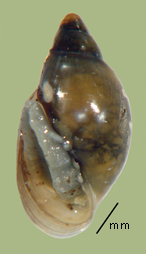> Habitat & Distribution
Although
their original
description included only a scattering of records from New England,
Taylor & Jokinen speculated that the range of Physa vernalis
might extend further west, to include Ohio, Michigan, and
perhaps part of Canada. Turner & Montgomery (2009)
did indeed report two populations of P. vernalis
from northwest Pennsylvania, and here we add a scattering of records
from northeastern Pennsylvania and Ohio as well.
Taylor & Jokinen described the habitat of P. vernalis
as small ponds, ditches, slow small streams, inlets to ponds,
and one known lake. They added that habitats tend
to be temporary or semi-temporary and that the water is
frequently rain-water derived and slightly acidic. Turner
& Montgomery (2009) reported that western Pennsylvania
populations
of P. vernalis
tend to
inhabit ponds of shorter hydroperiod than any other local physid,
minimizing their exposure to fish predation. The single
northeastern Pennsylvania population of which we are aware inhabits a (rather
pristine) bog pond, apparently restricted to clear, groundwater seeps
springing from marginal rock outcrops. Physa vernalis is
rare in our 17-state study region, FWGNA incidence rank I-2.
> Ecology & Life History
Although there have been no detailed ecological studies of this (still rather obscure) species, it seems reasonable to speculate that the general outlines of physid biology, as established from studies of better-known North American species, might apply (Dillon 2000: 66-70).
Dillon s (2000: 360-363) reanalysis of Jokinen s (1983) data on the distribution of P. vernalis in Connecticut suggested that such populations may be R-adapted, common in rich but unpredictable environments, demonstrating high reproductive efforts relative to body size.All physids seem to be preferential outcrossers, although self-fertilization is possible. Taylor & Jokinen reported that P. vernalis seems to demonstrate a simple annual (type A) life cycle in the Connecticut pond from which the species was described, adults and egg masses evident in the early spring. The pond dries in the summer, but growth is apparently quite rapid between the fall rains and the winter freeze.
> Taxonomy & Systematics
The penial morphology of Physa vernalis is characterized as type a, bearing an entirely glandular penial sheath in the fashion of the (more northern) Physa jennessi/skinneri and the (European) Physa fontinalis (Wethington & Lydeard 2007). And in fact, Taylor & Jokinen suggested that Physa vernalis may have escaped notice by two centuries of American malacologists because its shell morphology is in some sense intermediate between that of P. jennessi/skinneri and Aplexa hypnorum, another physid bearing an entirely glandular penial sheath (but no preputial gland). These morphological observations, together with an analysis of mtDNA sequence data, combined to suggest to Wethington & Lydeard that P. vernalis is phylogenetically intermediate between Aplexa and the more widespread and better known physids, such as P. acuta and P. gyrina.
> Maps and Supplementary Resources
- Physid distribution in tributaries of The Ohio (2019)
- Physa vernalis distribution in Atlantic drainages (2013)
> Essays
- The phylogenetic analysis of Wethington & Lydeard prompted me to review The Classification of the Physidae in my post of 12Oct07.
- The relationship between molecular phylogeny and reproductive isolation in the Physidae was explored in my post of 12July11, "What is a Species Tree?"
- See my post of 26Sept14 for good, comparative figures illustrating "The egg masses of freshwater pulmonate snails."
> References
Dillon, R. T., Jr. (2000) The
Ecology of Freshwater Molluscs. Cambridge University Press, Cambridge,
England. 509 pp.
Dillon, R. T., A. R. Wethington, and C. Lydeard (2011)
The evolution of reproductive isolation in a simultaneous
hermaphrodite, the freshwater snail Physa.
BMC Evolutionary Biology 11:144. [PDF] [html]
Jokinen, E. H.
1983. The Freshwater Snails of
Connecticut. Connecticut Natural History Survey Bulletin 109:
1 - 83.
Jokinen, E.H.
1992. The Freshwater Snails (Mollusca:
Gastropoda) of New York State. NY State Mus Bull 482, Albany, New
York.
Taylor, D. W. &.
E. H. Jokinen 1984. A new species of
freshwater snail (Physa)
from seasonal habitats in Connecticut. Freshwater
Invertebrate Biology 3: 189-202.
Te, G. A. 1978.
The
systematics of the family Physidae (Basommatophora: Pulmonata). Ph.D.
Dissertation, University of Michigan, pp. 325.
Te, G. A. 1980.
New classification for the family Physidae (Pulmonata: Basommatophora).
Arch. Moll. 110:179-184.
Turner, A. M. &
S. L. Montgomery. 2009.
Hydroperiod, predators and the distribution of physid snails
across the freshwater habitat gradient. Freshwater Biology
54:
1189-1201.
Wethington, A. R. 2004
Phylogeny, taxonomy, and evolution of reproductive isolation in Physa
(Pulmonata: Physidae) Ph.D. dissertation, University of Alabama,
Tuscaloosa.
Wethington, A. R.
& C. Lydeard 2007.
A molecular phylogeny of Physidae (Gastropoda: Basommatophora) based on
mitochondrial DNA sequences. J. Molluscan Stud. 73: 241 - 257
[PDF] .








